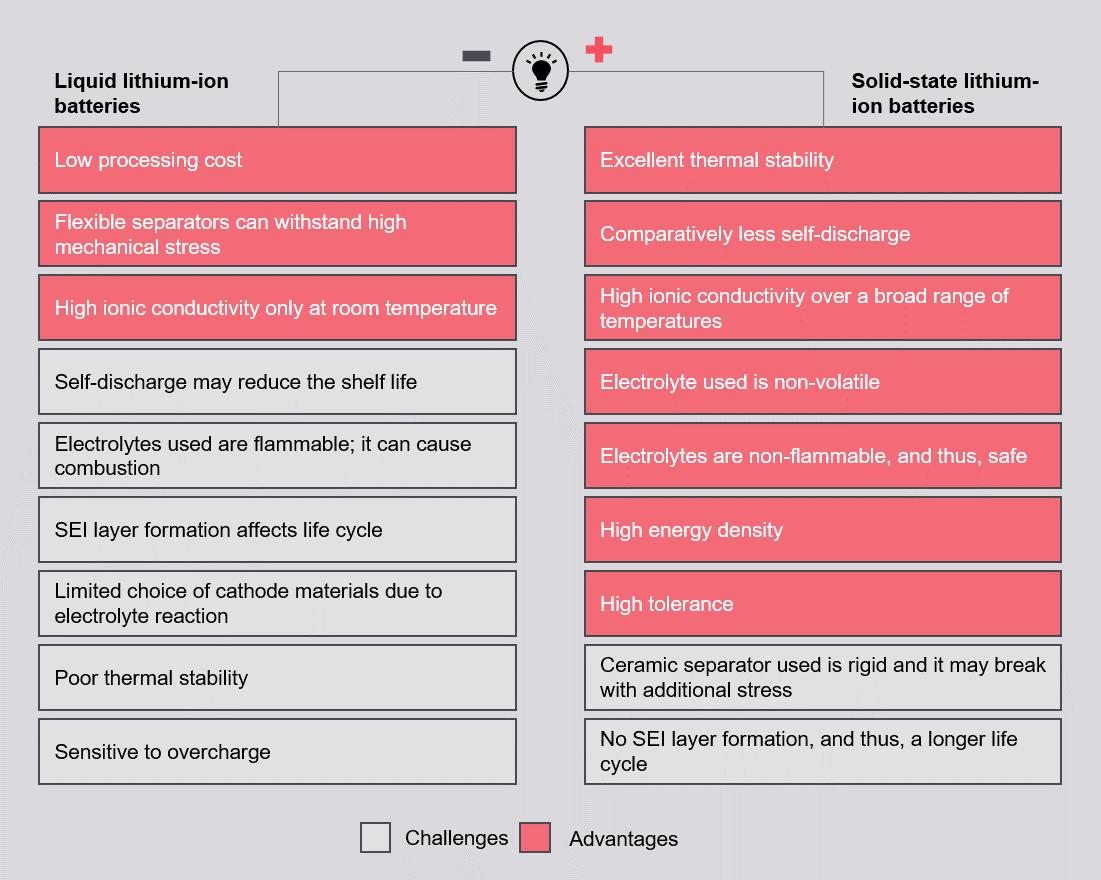Science & Technology
Solid-State Batteries
- 03 Jan 2022
- 6 min read
For Prelims: Solid-state batteries, difference between solid-state and Li-ion battery, types of batteries.
For Mains: Solid-state batteries, difference between solid-state and Li-ion battery, advantages of Solid-state batteries, role of modern Batteries in fighting climate change, how can modern batteries revolutionise the automobile industry.
Why in News
Car manufacturer Volkswagen plans to have production running for solid-state batteries by 2025 via the partnership with QuantumScape.
- QuantumScape’s solid-state battery — lithium metal with a solid electrolyte separating the two electrodes — is seen as an exceptionally bright prospect in an increasingly crowded space.
Key Points
- About:
- A solid-state battery has higher energy density than a Lithium-ion battery that uses liquid electrolyte solution. It doesn’t have a risk of explosion or fire, so there is no need to have components for safety, thus saving more space. Then we have more space to put more active materials which increase battery capacity in the battery.
- A solid-state battery can increase energy density per unit area since only a small number of batteries are needed. For that reason, a solid-state battery is perfect to make an Electric Vehicle (EV) battery system of module and pack, which needs high capacity.
- The energy density of lithium-ion cells used in today’s mobile phones and electric vehicles is nearly four times higher than that of older-generation nickel-cadmium batteries.
- Despite improvements in technology over the last decade, issues such as long charging times and weak energy density persist. While lithium-ion batteries are seen as sufficiently efficient for phones and laptops, they still lack the range that would make EVs a viable alternative to internal combustion engines.
Lithium-ion Batteries
- About:
- It uses an intercalated (Intercalation is the reversible inclusion or insertion of a molecule into materials with layered structures) lithium compound as one electrode material, compared to the metallic lithium used in a non-rechargeable lithium battery.
- The battery consists of electrolyte, which allows for ionic movement, and the two electrodes are the constituent components of a lithium-ion battery cell.
- Lithium ions move from the negative electrode to the positive electrode during discharge and back when charging.
- Lithium-ion Battery Applications:
- Electronic gadgets, Tele-communication, Aerospace, Industrial applications.
- Lithium-ion battery technology has made it the favourite power source for electric and hybrid electric vehicles.
- Disadvantages of Li-ion Batteries:
- Long charging times.
- One major problem is that lithium metal is extremely reactive. Safety issues as instances of batteries catching fires have been there.
- Expensive to manufacture.
- While the Li-ion batteries are seen as sufficiently efficient for applications such as phones and laptops, in case of EVs, these cells still lack the range that would make them a viable alternative to internal combustion engines.
- Advantages Over Li-ion:
- Higher Cell Energy Density:
- The advantages of the solid-state battery technology include higher cell energy density (by eliminating the carbon anode), lower charge time (by eliminating the need to have lithium diffuse into the carbon particles in conventional lithium-ion cells), ability to undertake more charging cycles and thereby a longer life, and improved safety.
- Cost Effective:
- Lower cost could be a game-changer, given that at 30% of the total cost, battery expenses are a key driver of the vehicle costs.
- QuantumScape claims it is targeting to lower battery cost by 15-20% relative to the cost of lithium-ion batteries in several years.
- Higher Cell Energy Density:
- Other Potential Alternatives to Solid-state Batteries:
- Graphene Batteries: Graphene batteries may be an important alternative to lithium-ion batteries, with the latter having limitations due to the frequency with which lithium requires charging. Graphene is a newly stabilised and isolated material.
- Fluoride Batteries: Fluoride Batteries have the potential to last eight times longer than lithium batteries.
- Sand Battery: This alternative type of lithium-ion battery uses silicon to achieve three times better performance than current graphite Li-ion batteries. The battery is still lithium-ion like the one found in a smartphone, but it uses silicon instead of graphite in the anodes.
- Ammonia-powered Batteries: Ammonia-powered batteries may not be coming any time soon, but the chemical commonly known as a household cleaner is still an alternative to lithium in the way it can power fuel cells in vehicles and other equipment.
- If scientists can figure out a way to produce ammonia without creating the greenhouse gas emissions that result right now, they can ship it anywhere in the world to be converted into hydrogen to power those fuel cells.
- Lithium-Sulphur Batteries: Researchers in Australia say they have developed the world’s most powerful rechargeable battery using lithium-sulphur, said to perform four times better than the strongest batteries currently available.
- Vertically Aligned Carbon Nanotube Electrode: These are good candidates for lithium-ion battery electrodes which require high rate capability and capacity.





